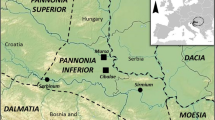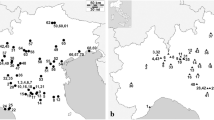Abstract
Our understanding of the introduction and adoption of new plant foods in Roman Britain is currently limited by a lack of data from a group of Late Iron Age settlements commonly referred to as oppida (large pre-Roman towns). This paper presents the first evidence of several imported plant foods from Late Iron Age Britain in the form of waterlogged plant remains from the oppidum at Silchester. These were recovered from the basal contexts of two wells, dated to the early first century a.d. One olive stone and several seeds of celery, coriander and dill were identified. The results are compared to archaeobotanical data from elsewhere in Britain and northwestern Europe, demonstrating that Silchester is part of the wider phenomenon of the adoption of new flavourings and fruits in Late Iron Age Europe.



Similar content being viewed by others
References
Bakels C (1999) Archaeobotanical investigations in the Aisne valley, northern France, from the Neolithic up to the early middle ages. Veget Hist Archaeobot 8:71–77
Bakels C, Jacomet S (2003) Access to luxury foods in central Europe during the Roman period: the archaeobotanical evidence. World Archaeol 34:542–557
Bertacchi A, Lombardi T, Sani A, Tomei PE (2008) Plant macroremains from the Roman harbour of Pisa (Italy). Envir Archaeol 13:181–188
Booth P, Dodd A, Robinson M, Smith A (2007) The Thames through time: the archaeology of the gravel terraces of the upper and middle thames: the early historical period, AD 1–1000. Oxford University School of Archaeology, Oxford
Collis J (2000) “Celtic” Oppida. In: Hansen M (ed) A comparative study of thirty city-state cultures: an investigation conducted by the Copenhagen Polis Centre (Historisk-filosofiske Skrifter 21). Kongelige dansk videnskabernes selskab, Copenhagen, pp 229–239
Cool HEM (2006) Eating and drinking in Roman Britain. Cambridge University Press, Cambridge
Creighton J (2006) Britannia: the creation of a Roman province. Cambridge University Press, Cambridge
Cunliffe B (1987) Hengistbury Head, Dorset. Volume: 1 the prehistoric and Roman settlement, 3500 BC-AD 500. Oxford University Committee for Archaeology, Oxford
Dalby A (2003) Food in the ancient world from A to Z. Routledge, London
Davis A (2011) Botanical remains. In: Hill J, Rowsome P (eds) Roman London and the Walbrook stream crossing: excavations at 1 poultry and vicinity, City of London. Museum of London Archaeology, London, pp 524–533 (MOLA Monograph 37)
De Moulins D (1996) Charred plant remains. In: Wainwright GJ, Davies SM (eds) Balksbury Camp, Hampshire Excavations 1973 and 1981. English Heritage, London, pp 87–92 (English Heritage Archaeol Rep 4)
Fitzpatrick AP (2003) Roman amphorae in Iron Age Britain. J Roman Pottery Stud 10:10–25
Fulford M, Timby J (2000) Late Iron Age and Roman Silchester: excavations on the site of the Forum Basilica, 1977, 1980–86. Society for the Promotion of Roman Studies, London
Fulford M, Clarke A, Eckardt H (eds) (2006) Life and labour in late Roman Silchester: Excavations in Insula IX since 1997. Society for the Promotion of Roman Studies, London, pp 206–218
Fulford M, Clarke A, Lucas S (2012) Silchester Insula IX: The “Town Life” Project 2011. Department of Archaeology, University of Reading, Reading
Giorgi J (2009) Plant remains. In: Cowan C (ed) Roman Southwark, settlement and economy: excavations in Southwark, 1973–91. Museum of London Archaeology, London, pp 242–243
Grant A (2007) Domestic animals and their uses. In: Todd M (ed) A companion to Roman Britain. Blackwell, Oxford, pp 371–392
Green FJ (1981) Iron Age, Roman and Saxon crops: the archaeological evidence from Wessex. In: Jones MK, Dimbleby DW (eds) The environment of man: the Iron Age to the Anglo-Saxon period. BAR Brit Ser 87, Oxford, pp 129–153
Greig J (1991) The British Isles. In: Van Zeist W, Wasylikowa R, Behre K-E (eds) Progress in old world palaeoethnobotany. Balkema, Rotterdam, pp 299–334
Grocock W, Grainger S (2006) Apicius: a critical edition with an introduction and an English translation of the Latin recipe text Apicius. Prospect, Totnes
Hall A, Kenward H (2003) Can we identify biological indicator groups for craft, industry and other activities? In: Murphy P, Wiltshire PEJ (eds) The environmental archaeology of industry. Oxbow Books, Oxford, pp 114–130
Haselgrove C (1976) External trade as a stimulus to urbanisation. In: Cunliffe B, Rowley T (eds) Oppida, the beginnings of urbanisation in barbarian Europe. (BAR Suppl Ser 11), British Archaeological Reports, Oxford, pp 25–49
Hill JD (2007) The dynamics of social change in later Iron Age eastern and south-eastern England c. 300 BC-AD 43. In: Haselgrove C, Moore T (eds) The later Iron Age in Britain and beyond. Oxbow Books, Oxford, pp 16–40
Huckerby E, Graham F (2009) Waterlogged and charred plant remains. In: Howard-Davis C (ed) The Carlisle millennium project: excavations in Carlisle 1998–2001, vol 2. Oxford Archaeology North, Lancaster, pp 927–936
Jones M (2000) The plant remains. In: Fulford MG, Timby J (eds) Late Iron Age and Roman Silchester: excavations on the site of the Forum Basilica, 1977, 1980–86. Society for the Promotion of Roman Studies, London, pp 505–512
Kreuz A, Wiethold J (2010) Archäobotanische Ergebnisse der eisen- und kaiserzeitlichen Siedlung Mardorf 23, Lkr. Marburg-Biedenkopf. Hinweise auf kulturelle Beziehungen nach Süden und Norden. In: Jérem E, Schönfelder M, Wieland G (eds) Nord-Süd, Ost-West Kontakte während der Eisenzeit in Europa. Budapest, Archaeolingua, pp 151–163
Livarda A, Van der Veen M (2008) Social access and dispersal of condiments in North-West Europe from the Roman to the medieval period. Veget Hist Archaeobot 17(Suppl 1):201–209
Mattingly D (1996) First fruit? The olive in the Roman world. In: Salmon JB, Shipley G (eds) Human landscapes in classical antiquity: environment and culture. Routledge, London, pp 213–253
Meadows K (2002) The appetites of households in early Roman Britain. In: Allison M (ed) The archaeology of household activities. Routledge, London, pp 101–116
Meyer F (1980) Carbonized food plants of Pompeii, Herculaneum and the villa at Torre Annunziata. Econ Bot 34:401–437
Müldner G (2013) Stable isotopes and diet: their contribution to Romano-British research. Antiquity 87:137–149
Murphy P (1984) Environmental archaeology in East Anglia. In: Keeley HCM (ed) Environmental archaeology: a regional review. Department of the Environment, London, pp 13–42
Murphy P (2003) Plant macrofossils. In: Germany M (ed) Excavations at Great Holts Farm, Boreham, Essex, 1992–1994, vol 105. East Anglian Archaeology, Chelmsford, pp 204–213
Murphy C, Thompson G, Fuller DQ (2012) Roman food refuse: urban archaeobotany in Pompeii, Regio VI, Insula 1. Veget Hist Archaeobot. doi:10.1007/s00334-012-0385-8
Pelling R (2005) Seeds and charcoals. In: Manley DJ, Rudkin D (eds) A Pre-a.d. 43 ditch at Fishbourne Roman palace, vol 36. Britannia, Chichester, p 86
Pitts M (2010) Re-thinking the southern British oppida: networks, kingdoms and material culture. Eur J Archaeol 13:32–63
Rackham H (ed) (1968) Pliny: natural history IV. Heinemann, London
Robinson M (2011) The macroscopic plant and invertebrate remains. In: Fulford M, Clarke A (eds) Silchester: city in transition. Society for the Promotion of Roman Studies, London, pp 281–293
Robinson M (2012) The place of Silchester in archaeobotany. In: Fulford M (ed) Silchester and the study of Romano-British urbanism. (JRA Suppl Ser 90), Journal of Roman Archaeology, Rhode Island, pp 213–225
Robinson M, Fulford N, Tootell K (2006) Macroscopic plant remains. In: Fulford M, Clarke A, Eckardt H (eds) Life and labour in late Roman Silchester: Excavations in Insula IX since 1997. Society for the Promotion of Roman Studies, London, pp 206–218
Rottoli M, Castiglioni E (2011) Plant offerings from Roman cremations in northern Italy: a review. Veget Hist Archaeobot 20:495–506
Sealey PR, Tyers PA (1989) Olives from Roman Spain: a unique amphora find in British waters. Antiqu J 69:53–72
Stace C (1997) New flora of the British isles. Cambridge University Press, Cambridge
Sykes N (2009) Worldviews in transition: the impact of exotic plants and animals on Iron Age/Romano-British landscapes. Landscapes 10:19–36
Van der Veen M (1996) The plant macrofossils from Dragonby. In: May J (ed) Dragonby, report on the excavations at an Iron Age and Romano-British Settlement in north Lincolnshire. Oxbow Books, Oxford, pp 173–214
Van der Veen M (2003) When is food a luxury? World Archaeol 34:405–427
Van der Veen M (2007) Formation processes of desiccated and carbonized plant remains—the identification of routine practice. J Archaeol Sci 34:968–990
Van der Veen M (2008) Food as embodied material culture: diversity and change in plant food consumption in Roman Britain. J Rom Archaeol 21:83–109
Van der Veen M, Livarda A, Hill A (2007) The archaeobotany of Roman Britain: current state and identification of research priorities. Britannia 38:181–210
Van der Veen M, Livarda A, Hill A (2008) New plant foods in Roman Britain—dispersal and social access. Envir Archaeol 3:11–36
Wiethold J (1996) Late Celtic and early Roman plant remains from the oppidum of Bibracte, Mont Beuvray (Burgundy, France). Veget Hist Archaeobot 5:105–116
Wiethold J (2010) L’histoire et l’utilisation de la coriandre (Coriandrum sativum L.), à partir du deuxième âge du Fer jusqu’au début de l’époque moderne. Culture, utilisation, sources écrites et données carpologiques. In: Delhon C, Théry-Parisot I, Thiébault S (eds) Des hommes et des plantes. Exploitation du milieu et gestion des ressources végétales de la préhistoire à nos jours. Editions APDCA, Juan-les-Pins, pp 141–159
Zech-Matterne V, Bouby L, Bouchette A, Cabanis M, Derreumaux M, Durand F, Marinval P, Pradat B, Sellami M-F, Wiethold J (2009) L’agriculture du VIe au Ier sie`cle avant J.-C. en France: état des recherches carpologiques sur les établissements ruraux. In: Bertrand I, Duval A, Gomez de Soto J, Maguer P (eds) Habitats et paysages ruraux en Gaule et regards sur d’autres régions du monde celtique, tome II. Assoc des Publications Chauvinoises (Mémoire XXXV), Chauvigny, pp 383–416
Acknowledgments
I would like to thank the excavation directors, Mike Fulford and Amanda Clarke, University of Reading, who gave me the opportunity to study these samples. I am grateful to my supervisor Mark Robinson for his help on the identification and his comments on this paper, to Alison Crowther for discussion and comments on the text and to the reviewers and editor for their helpful comments. Funding was provided to the author by the Arts & Humanities Research Council and for the Silchester ‘Town Life’ Project by the Headley Trust.
Author information
Authors and Affiliations
Corresponding author
Additional information
Communicated by M. van der Veen.
Electronic supplementary material
Below is the link to the electronic supplementary material.
Rights and permissions
About this article
Cite this article
Lodwick, L. Condiments before Claudius: new plant foods at the Late Iron Age oppidum at Silchester, UK. Veget Hist Archaeobot 23, 543–549 (2014). https://doi.org/10.1007/s00334-013-0407-1
Received:
Accepted:
Published:
Issue Date:
DOI: https://doi.org/10.1007/s00334-013-0407-1




